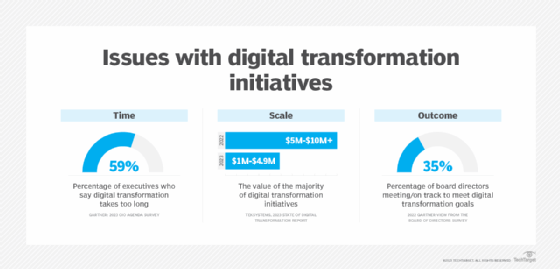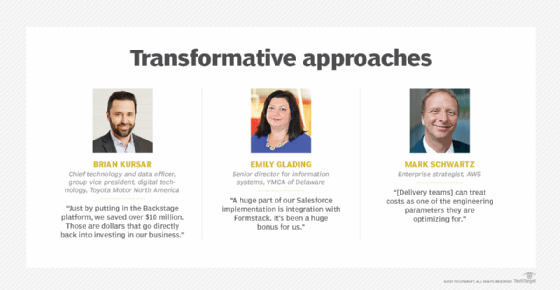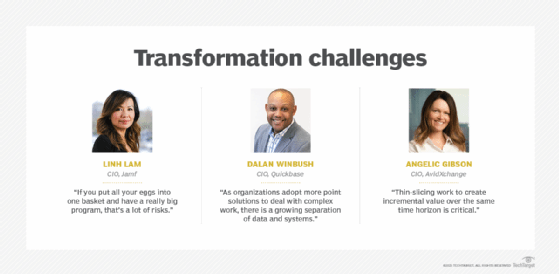
Getty Images
IT leaders drive evolution of digital transformation
Some CIOs are redefining digital transformation, while others abandon the term. What comes next will feature smaller projects, higher levels of automation and a dose of pragmatism.
CIOs, having lived through years of digital transformation, are now taking a fresh look at the practice and how it fits -- or doesn't -- in today's abruptly changing, uncertain world.
A decade ago, digital transformation emerged as an antidote to digital disrupters upending the corporate status quo. Traditional businesses would need to fundamentally change and adopt digital business models to survive. The transformation trend got a reinforcing push from COVID-19, which caused companies that hadn't yet to rapidly digitalize.
The pandemic revealed some of the limitations within the digital transformation program, chiefly that initiatives were a bit ponderous and must move faster. The subsequent overlapping crises of inflation, European warfare and slower business spending have only underscored the need to revisit digital transformation.
Linh Lam, CIO of Jamf, an Apple device security company based in Minneapolis, has led transformations at various companies since 2012. Digital transformation became a buzzword over the years, and Lam suggested businesses now experience a certain amount digital transformation fatigue.
"It's been around for a long time," she said. "We've seen a lot of large programs go very successfully -- and we've seen a lot of large programs look completely different at the end."
IT managers point to several ways they're changing up digital transformation or avoiding it altogether. Those include a shift to shorter, focused initiatives; an emphasis on hyperautomation; an increase of agile approaches; and a predilection for projects that integrate existing IT systems in effective ways.

A shift to smaller initiatives
The reason big deals may never arrive at their initially intended destinations has to do with scale. Sweeping, change-the-business projects take time to complete, and fast-moving events tend to overtake them.
"The speed of business doesn't wait for you to finish up your programs," Lam said. "Your operations and your investments tend to react to what we're going through right now with all the macroeconomic-type changes."
As a result, the large-scale, long-haul projects of previous years are giving way to smaller, quicker efforts.
"When I think about transformation now, I try to steer away from using that broad term and thinking more in terms of more focused initiatives," Lam explained.
That calls for understanding the value a business aims to achieve across different time horizons, from the immediate to the long term. In the near term and midterm, an organization can likely find ways to reach its objectives without running a huge program, Lam said.
"If you put all your eggs into one basket and have a really big program, that's a lot of risks," Lam said. "It only takes one or two things to go off course to delay the entire program. And that's where the fatigue really sets in."
Diversity and digital adoption
Diverse teams are a must for effective technology uptake. Demographics influence how people use technology, but IT leaders can miss the subtleties.
Jamf's Lam pointed to the difference in how she uses technology tools and websites compared with her parents and her 10-year-old daughter.
"The way that she interacts with things is very different from how I interact with them, and I think I'm decently savvy versus my parents, who need a lot more help," she explained. "Depending upon the type of business you're in, you have to have a really good understanding of the demographics of the customer base."
The same principle applies to cultural differences. Lam's customers -- Jamf employees -- extend beyond the U.S.
"I can't just have a team that's only sitting in the U.S., trying to think of solutions for team members that … may be sitting in Poland or the Czech Republic," she said.
Projects vary in duration depending on scope, but Lam said she likes to deliver value within two quarters. "Six months seems long enough -- you could do a lot in terms of delivery -- but also short enough where people aren't going to lose their patience," she noted. "Anything that pushes to about a year, you run the risk of the business changing or requirements changing along the way."
Large-scale transformation isn't obsolete, however. Lam cited the example of a company that seeks to manage its digital assets but lacks a content management system. Those sorts of projects, where the business essentially starts from zero, need to be bigger. That said, even larger programs can be segmented into phases that demonstrate value over the course of the initiative, Lam added.
Automation as transformation
For Brian Kursar, chief technology and data officer, group vice president, digital technology, at Toyota Motor North America (TMNA), automation stands out as the new look of digital transformation. The company had been using the cloud, which many businesses tap as an agent of transformation, for nearly a decade. But its thinking on how best to run the cloud took a different turn in 2021.
"What's really changed for me is this term: hyperautomation," he said. "You're getting out of [COVID-19], and you're recognizing that we were doing stuff pretty well, but a lot of it was manual. We did not have all of our processes automated. So that's where we really took a step back."
TMNA's software developers had been working in a process-centric cloud. A developer needing a cloud environment filled out a request form, which was reviewed, and the cloud instance was provisioned. An issue with the environment -- a developer not having the right level of access, for example -- would require another form to rectify.
"Honestly it was cloud done the wrong way," Kursar said.
TMNA two years ago rolled out a development platform based on Spotify Backstage, an open source technology for creating developer portals. The platform, which developers use to build and manage applications on AWS, automated previously manual processes. Self-service features, for instance, replace filling out forms. The automated services also embed the company's security protocols and cost-tracking guardrails.
Automation as transformation helps TMNA take costs out of its IT infrastructure. This frees up funding for additional innovation.
"Just by putting in the Backstage platform, we saved over $10 million," Kursar said. "Those are dollars that go directly back into investing in our business."
As a result, TMNA can increase its focus on data science and analytics. "We're working with the business to connect datasets that they've never been able to connect before," Kursar said.
Chaining datasets together helps the company understand the customer journey and the steps along the way that determine whether a customer buys another Toyota. Doing so is far from cheap. The task requires robust data warehouses and data lakes to support cross-functional queries, Kursar noted.
"If we don't automate the majority of the heaving lifting, we are never going to be able to focus on those value-add initiatives," he said. "I always tell my team, 'Automation is our salvation.'"

Agile vs. digital transformation
Enterprise-wide agility, rather than digital transformation, has become the guiding IT strategy at Quickbase, a no-code platform provider based in Boston.
Dalan Winbush, CIO at Quickbase, called digital transformation an "overly saturated term." Instead Winbush pursues agile practices such as the Scaled Agile Framework (SAFe). The idea is to help the business weather rapidly changing business cycles.
"Predicting the unpredictable is the new market differentiator," Winbush said.
Hyper-fragmentation, however, blocks the path to agility, he added. This condition, which results in operational friction, stems from layers of disparate technologies. CIOs have identified interoperability as among the key challenges of 2023.
"As organizations adopt more point solutions to deal with complex work, there is a growing separation of data and systems," Winbush said.
Hyper-fragmentation surfaces in a business' processes, where inconsistent execution becomes an issue. SAFe plays a role here, providing a set of practices for adopting Agile methodologies for rapidly delivering high-quality products and services. Winbush said structured frameworks like SAFe Agile helps enterprises "drive predictability through uncertainties."
The objective is to ensure a business concentrates on its most pressing agenda items. Quickbase uses what Winbush called "intentional ceremonies" to make sure that happens. Those ceremonies include annual operating planning, which aligns programs, initiatives and teammates to focus them on the most valuable work; quarterly programming to focus on quarterly and monthly deliveries; a monthly cadence of progress check-ins on quarterly goals; and 2-week sprints ensure working teams can achieve their most valuable deliverables.
This approach lets Quickbase pivot when necessary instead of becoming reactive to market or competitive climate changes.
Managing cloud transformation costs
Condensing digital transformation initiatives can make them easier to manage. But organizations also need to make them more cost effective -- with the cloud being one area ripe for expense reduction.
Mark Schwartz, an enterprise strategist at AWS and former CIO of U.S. Citizenship and Immigration Services, said he views cloud cost management as an ongoing task rather than a one-time infrastructure investment consideration.
In addition the cloud cost management burden should be shared more widely within organizations. "The responsibility for managing cost is no longer simply a centralized responsibility," he noted.
While CIOs and CFOs continue their traditional cost-management roles, distributed IT delivery teams can also contribute.
"They can treat costs as one of the engineering parameters they are optimizing for," Schwartz said. "They can write code to consume fewer resources in the cloud and select instance types that are less expensive to run."
Disconnected systems and data, meanwhile, lead to duplication of work, miscommunication and execution delays, according to Winbush. Fragmented systems then contribute to process problems. Process flows are duplicated or interrupted when a network of systems can't share information at the point of transaction, whether a system or a human, he said.
IT leaders should build connections between systems to ease information sharing, Winbush advised. He also recommended pulling disparate data into a single source, a move that supports processes, decision-making and data visibility. Bringing together workflows and data facilitates cross-functional work, he added.
Pragmatic integration
Digital transformation often hinges on a new application. But for the YMCA of Delaware, its latest round of transformation focuses on integrating existing systems.
The organization's core membership-management applications are Salesforce and Formstack. In 2019 the YMCA of Delaware deployed Salesforce components including Nonprofit Success Pack and Experience Cloud. Its use of Formstack's form creation and workflow automation software goes back even further -- about 10 years.
Emily Glading, senior director for information systems at YMCA of Delaware, said the organization originally used Formstack to fill in some feature gaps its older CRM system didn't address. Once the YMCA switched to Salesforce CRM, however, Glading saw a new possibility: connecting Formstack's forms to Salesforce.
"A huge part of our Salesforce implementation is integration with Formstack," she said. "It's been a huge bonus for us."
The Formstack-Salesforce integration helps the organization track customer requests such as membership holds. A member can ask the YMCA to temporarily suspend membership and pause the monthly fee -- an action that requires a written request. But the integration lets a member submit a request through Formstack. Data from the form flows into Salesforce as a case, which lets YMCA personnel keep tabs on customer issues. YMCA staff can pull stats on how many requests they receive and how fast those requests are being processed, Glading noted.
The integration also automates workflows surrounding member contracts and liability wavers. Around 14,000 new members join the YMCA of Delaware each year. The Formstack-Salesforce connection eliminates manual data entry and avoids other problems such as illegible handwriting.
"It's really improved efficiency and accuracy," Glading said.
Agility is another offshoot of the YMCA's expanded use of Formstack. The no-code platform lets the YMCA of Delaware's three-person IT staff -- and designated users, such as branch business managers -- quickly create forms as the need arises. Glading cited the example of field trip permission slips, which the organization created in a matter of minutes. Parents fill out the Formstack-created slips, and the data is stored and accessible via Salesforce.
A permission slip form is a small project that makes a big difference. The YMCA of Delaware relies on such documentation for risk management and state licensing.
"It's not glamorous," Glading said. "But we can come up with a solution to a problem that someone is having -- and we're not going to have to outsource and have someone else develop it for us."

A multi-pronged approach
Digital transformation can stall when organizations fall short on any one of the key dimensions: people, process and technology. A business might need to simultaneously address more than one of the above.
Angelic Gibson, CIO of AvidXchange, a fintech in Charlotte, N.C., suggested CIOs pay attention to organizational skillsets, instill agility and restructure the scope of initiatives to keep transformation on track.
Creating a workforce ready to deal with an influx of emerging technology is one requirement.
"When approaching digital transformation, executives have to remain focused on putting people in the right seats to drive success," Gibson said.
CIOs planning to deploy new tools and promote innovation should determine whether their people have the right skills to be successful. "If not, it should become their responsibility as a leader to develop this person," she said.
IT leaders should also challenge themselves to be agile, focusing on accelerating speed to market, Gibson said. They should launch training and enablement programs to help employees become agile as well, she noted. "Though digital transformation centers around agility, people are not always agile."
Large-scale initiatives can be restructured as smaller projects with quicker returns, Gibson noted.
"Thin-slicing work to create incremental value over the same time horizon is critical," she said.







